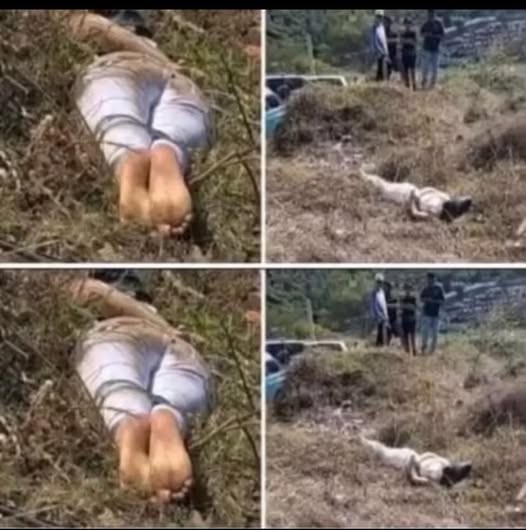
In the ceaseless rhythm of city life, where hurried footsteps and honking cars create a constant background of motion, small moments often go unnoticed. But sometimes, a fleeting encounter—a single figure in the crowd—reveals layers of human experience and vulnerability that we rarely consider. One such moment unfolded recently when a woman was found stranded, unable to secure a cab in the bustling heart of the city.
The Initial Report
At 11 a.m., local authorities received a report that immediately drew attention. A woman, appearing frail and thin, was spotted standing alone on a busy street. Those who first noticed her described someone who seemed to have recently been discharged from a hospital, her movements slow, deliberate, and careful. Concerned witnesses alerted police, who promptly arrived to inspect the scene and ensure her safety.
Authorities wasted no time coordinating with medical services. An ambulance was called, and the woman was taken to the Prek Phon Health Center for thorough examination. While the medical team worked to assess her condition, the circumstances surrounding her presence in that area became a focal point for deeper reflection on urban life and the quiet struggles of city dwellers.
A Moment in the Evening Hustle
By 6 p.m., the city was fully immersed in its evening routine. The sky dimmed as the sun dipped below the horizon, and traffic thickened, creating a cacophony of engines, horns, and hurried conversations. Amid this orchestrated chaos, the woman stood on the curb near a busy intersection, attempting to flag down a taxi.
To any passerby, she might have seemed like just another figure among hundreds, waiting for transport. Yet there was something different—something subtle—that caught the eye of a stranger who paused, just for a moment. Her face reflected more than the fatigue of a long day; it carried the weight of uncertainty and quiet desperation. Her eyes, tired yet alert, told a story of struggle hidden beneath the veneer of urban normalcy.
Her handbag was clutched tightly, not in casual possession but as if holding onto a fragile lifeline. The taxis that passed by—full, indifferent, or preoccupied—did not notice the urgency in her stance. For her, each missed opportunity to secure a ride amplified a sense of isolation in a city that rarely pauses to notice individual vulnerability.
The Larger Urban Context
Scenes like this are more than anecdotal—they reflect the complex realities of life in densely populated urban centers. Cities, by their nature, are spaces of anonymity. Individuals can easily disappear into crowds, their struggles invisible to those rushing past. Yet, it is precisely these overlooked moments that reveal the human side of urban existence, the quiet crises that persist behind the noise of daily routines.
In this case, the woman’s struggle to secure transportation was not merely about convenience—it symbolized a broader societal challenge. Many city residents face barriers to mobility, health, and access to care, often compounded by systemic issues such as healthcare gaps, public transportation limitations, and social isolation. Her situation highlighted the intersection of these challenges, crystallized in a single, vulnerable moment on the sidewalk.
Police and Medical Response
The swift response from local authorities underscores the importance of vigilance in public spaces. Police officers arrived promptly to assess the scene, ensuring the woman’s immediate safety and coordinating with medical professionals. Their involvement was crucial in preventing potential harm and providing the first step toward addressing her needs.
An ambulance soon arrived, and the woman was transported to the Prek Phon Health Center for evaluation. Medical personnel examined her carefully, looking for signs of physical distress, fatigue, and potential complications from any recent hospitalization. This intervention not only ensured her immediate well-being but also highlighted the importance of coordinated civic response in urban environments.
Observations from Witnesses
Witnesses who paused to observe the woman often remarked on her demeanor. She moved with deliberate care, each step measured, revealing both vulnerability and resilience. Her presence invited empathy, a reminder that even amid the relentless pace of city life, small acts of awareness and kindness can make a significant difference.
Some bystanders noted the contrast between her quiet persistence and the impersonal rhythm of the city around her. Cars sped past, drivers preoccupied with their own schedules, while pedestrians hurried to reach their destinations. The woman’s struggle became a mirror reflecting the often-overlooked humanity embedded in urban spaces.
The Symbolism of a Struggle
While it may appear trivial—a woman struggling to hail a cab—the deeper significance is profound. Her experience symbolizes the challenges faced by many vulnerable individuals in urban centers. It highlights the delicate balance between personal agency and systemic obstacles, illustrating how easily small crises can escalate when unnoticed.
This moment serves as a reminder of the broader social fabric, emphasizing empathy, awareness, and community responsibility. Struggles that appear minor to some are, in fact, indicative of larger patterns of vulnerability that deserve attention and care.
Community Awareness and Civic Responsibility
Urban societies thrive when individuals and institutions respond to moments of vulnerability. The immediate actions of witnesses, police, and medical personnel exemplify civic responsibility in practice. Coordinated response—alerting authorities, providing aid, and ensuring medical evaluation—reflects the potential for small, attentive actions to mitigate broader crises.
The incident also invites reflection on long-term measures to support vulnerable populations. Access to reliable transportation, improved healthcare follow-up, social support networks, and public awareness initiatives can all play a role in reducing the likelihood of such situations recurring.
Human Resilience Amid Isolation
The woman’s persistence, standing alone amid the bustling city, speaks to a quiet resilience. Her ability to navigate uncertainty, seek assistance, and remain composed despite fatigue and potential health concerns is emblematic of the strength often required in urban life. Such resilience is rarely celebrated, yet it sustains individuals through daily challenges, bridging gaps between personal need and systemic limitations.
Her story invites broader reflection: How can societies better recognize and support such resilience? What measures can be taken to ensure that vulnerable individuals do not face their struggles in isolation? Addressing these questions is essential for fostering a more compassionate and responsive urban environment.
Broader Implications for Urban Life
The scene also highlights key aspects of urban planning, social services, and public policy. Cities must balance efficiency and growth with accessibility and inclusion. Ensuring that public spaces are safe, transportation options are available, and health and social services are responsive is crucial for the well-being of all residents, especially those recently discharged from medical care or otherwise at risk.
Moments like these underscore the invisible challenges faced by urban dwellers: fatigue, mobility issues, social isolation, and health vulnerabilities. Recognizing these challenges is the first step toward developing infrastructure, policies, and community practices that support human dignity and resilience.
The Role of Empathy
Amid the rush of city life, the importance of empathy cannot be overstated. Those who paused to notice the woman, who alerted authorities, and who provided care exemplified the impact of awareness and compassion. In an environment often characterized by anonymity, empathy transforms ordinary encounters into meaningful interventions, preventing small struggles from becoming crises.
This narrative encourages readers to remain attentive, proactive, and responsive in their communities. A simple act of noticing someone in need—alerting authorities, offering assistance, or even providing reassurance—can have far-reaching consequences for both individuals and the broader social fabric.
Conclusion: Small Moments, Big Lessons
The story of the woman stranded without a cab is more than an isolated urban incident. It is a microcosm of the challenges faced by vulnerable populations in cities worldwide: the interplay of fatigue, health concerns, social isolation, and systemic gaps. It demonstrates how swift, compassionate intervention—from witnesses, police, and medical personnel—can prevent escalation and provide meaningful support.
Urban life is filled with countless fleeting moments, many overlooked, but each carries the potential to reveal deeper truths about resilience, vulnerability, and human interconnectedness. By paying attention, acting with empathy, and supporting vulnerable individuals, cities can transform routine encounters into opportunities for compassion, solidarity, and positive social change.
In the end, this incident is a reminder that even amidst the pace and chaos of modern urban life, small acts of care—an alert passerby, a prompt police response, a timely medical check—can significantly impact lives. It encourages readers to recognize the unseen struggles around them, fostering communities where vigilance, empathy, and human dignity are not just ideals, but practiced realities.




